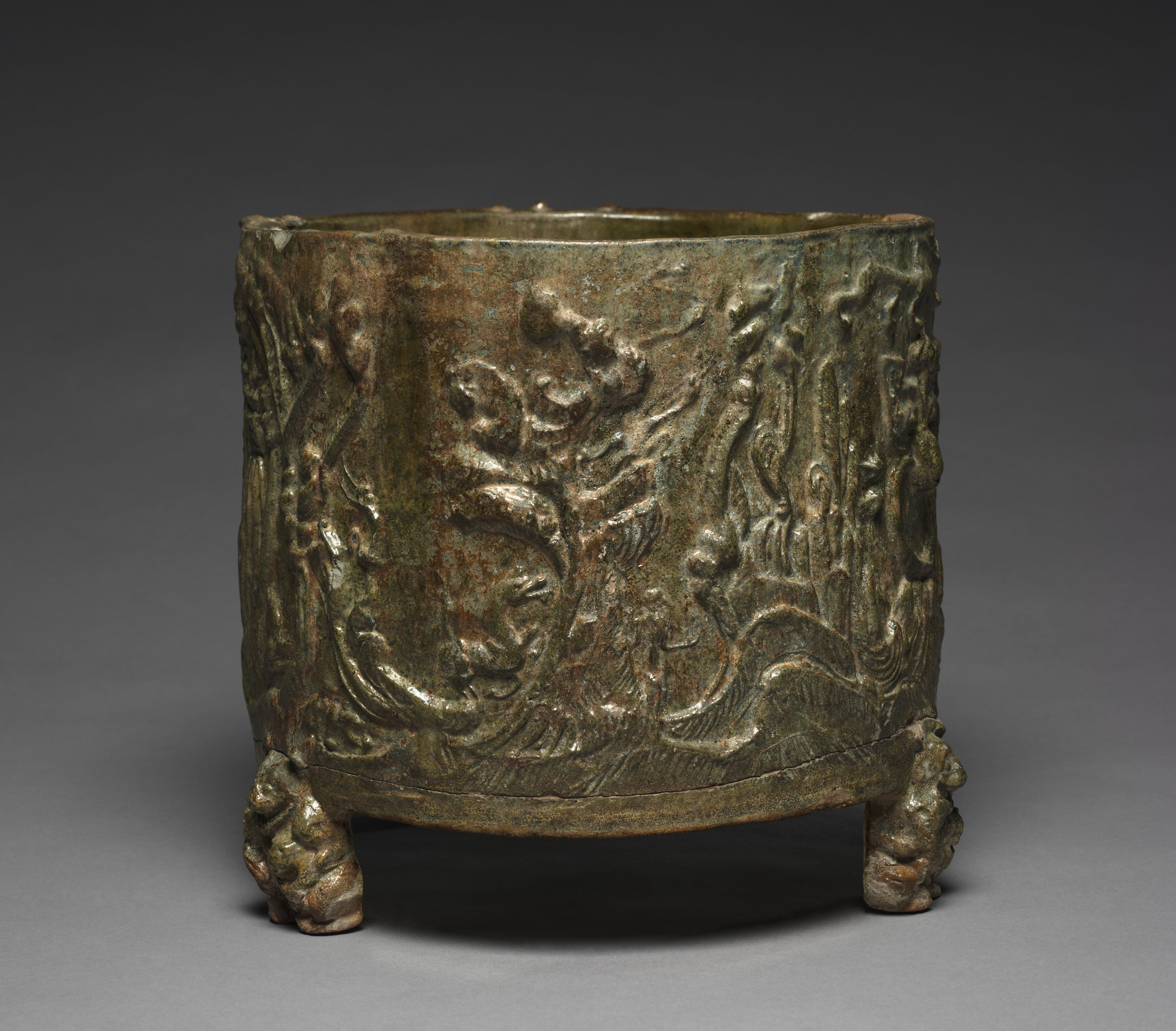The Cleveland Museum of Art
Collection Online as of April 20, 2024

Cylindrical Jar
202 BCE–220 CE
(202 BCE–220 CE)
Diameter: 27.3 cm (10 3/4 in.); height: 26.7 cm (10 1/2 in.)
Purchase from the J. H. Wade Fund 1948.214
Location: not on view
Did You Know?
The three feet are in the form of seated bears holding cubs.Description
Vessels like this often are call "hill jars" since many survive with conical covers shaped in rising peaks. "Squatting bear" feet and false animal-mask ring handles are common to the group. This cylinder has been molded in two relief bands depicting hills and three populated with a medley of real and imaginary creatures. Wispy human-like figures are associated with a popular cult of Taoism prevalent in China during the Han Dynasty. The scene may represent a paradise of immortality idealized by that cult and appropriate to this vessel's offering as a burial gift. When excavated from Han tombs, similar jars have been found to hold animal bones or powder; they may have served as food or cosmetic containers. Regardless of symbolism or function, this piece provides evidence for the appearance of early landscape lost in more fragile media.- ? by 1914–1948(Dikran G. Kelekian [1867–1951], New York, NY, sold to the Cleveland Museum of Art)1948–The Cleveland Museum of Art, Cleveland, OH
- Getz, John. The Kélékian Collection of Ancient Chinese Potteries. Chicago: The Art Institute of Chicago, 1917. Mentioned: no. 121, p. 45Lee, Sherman E. Chinese Landscape Painting. Cleveland, OH: The Cleveland Museum of Art, 1954. Mentioned: p. 144, cat. no. 4; Reproduced: p. 12 archive.orgThe Cleveland Museum of Art. The Cleveland Museum of Art Handbook. Cleveland, OH: The Cleveland Museum of Art, 1958. Mentioned and Reproduced: cat. no. 809 archive.orgThe Cleveland Museum of Art. Handbook of the Cleveland Museum of Art/1966. Cleveland, OH: The Cleveland Museum of Art, 1966. Reproduced: p. 247 archive.orgThe Cleveland Museum of Art. Handbook of the Cleveland Museum of Art/1969. Cleveland, OH: The Cleveland Museum of Art, 1969. Reproduced: p. 247 archive.orgThe Cleveland Museum of Art. Handbook of the Cleveland Museum of Art/1978. Cleveland, OH: The Cleveland Museum of Art, 1978. Reproduced: p. 327 archive.orgNeils, Jenifer. The World of Ceramics: Masterpieces from the Cleveland Museum of Art. Cleveland, OH: The Museum in cooperation with Indiana University Press, 1982. Mentioned and reproduced: pp. 83–85, no. 89Little, Stephen. Realm of the Immortals: Daoism in the Arts of China: the Cleveland Museum of Art, February 10-April 10, 1988. Cleveland, OH: The Cleveland Museum of Art in cooperation with Indiana University Press, 1988. cat. no. 10Wilson, J. Keith. "Powerful Form and Potent Symbol: The Dragon in Asia." The Bulletin of the Cleveland Museum of Art 77, no. 8 (1990): 286-323. Reproduced: cat. no. 26, p. 318 www.jstor.org
- Powerful Form and Potent Symbol: The Dragon in Asia. The Cleveland Museum of Art, Cleveland, OH (organizer) (July 24-November 25, 1990).Realm of the Immortals: Daoism in the Arts of China. The Cleveland Museum of Art, Cleveland, OH (organizer) (February 10-April 10, 1988).Realm of the Immortals: Daoism in the Arts of China: the Cleveland Museum of Art. The Cleveland Museum of Art, Cleveland, OH (February 10-April 10, 1988).The World of Ceramics: Masterpieces from the Cleveland Museum of Art. The Cleveland Museum of Art, Cleveland, OH (organizer) (June 30-September 5, 1982).Chinese Landscape Painting. The Cleveland Museum of Art, Cleveland, OH (organizer) (November 5-December 26, 1954).The Kélékian Collection of Ancient Chinese Potteries. Art Institute of Chicago, Chicago, IL (1917).? Exhibition. Musée des Arts Decoratifs, Louvre, Paris, France (1914).
- {{cite web|title=Cylindrical Jar|url=false|author=|year=202 BCE–220 CE|access-date=20 April 2024|publisher=Cleveland Museum of Art}}
Source URL:
https://www.clevelandart.org/art/1948.214